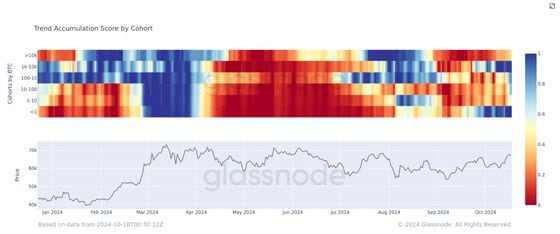Bitcoin Isn’t at a Record Like Gold and S&P 500, but an Overlooked Catalyst Suggests a Coming Change

- Gold has made another all-time high, climbing through $2,700 per ounce, as has the S&P 500, which rose above 5,870 on Thursday.
- While bitcoin is up 15% from the October low and appears set to rechallenge the $70,000 level, it remains about 8% below its record high recorded seven months ago.
- A fresh weakening trend in the Japanese yen bodes well for risk assets going forward.

Unmute

00:57Bitcoin Up 40% YTD But Underperforms Gold When Adjusted for Risk

01:01Bitcoin Breaks $64K While Gold Soars

00:56ETH/BTC Ratio Slid to Lowest Since April 2021

00:55Bitcoin Decouples From Gold. Is Crypto in a Bear Market Again?
Bitcoin’s (BTC) 8% rally this week has, outperformed gold and the S&P 500, but the cryptocurrency is still below its all-time high, while the yellow metal and benchmark U.S. stock index each climbed to new records.
At $2,718, gold is up 32% year-to-date and on its way to its best annual performance since 2010, when it rose 38%. The S&P 500, meanwhile, is ahead about 23% for 2024. Though not joining in the fun of new records after what’s now a seven-month period of sideways-to-lower prices, bitcoin remains higher by over 50% year-to-date.
Why no new record for bitcoin?
Perhaps the chief reason for bitcoin’s sluggish action since putting in a record high above $73,700 all the way back in March is “too far, too fast.” At that point, the price of the globe’s largest crypto was up nearly five-fold from 14 months earlier, including almost a doubling in just the first 10 weeks of 2024.
Getting into more detail, there was also plenty of forced sell pressure over the summer when the German government moved to market its large stash of seized bitcoin and the Mt Gox trustee began returning tokens to their owners.
There’s also the fact that bitcoin trades 24/7 and is thus subject to a lot more leverage and volatility than other assets. This in turn can lead to a lot more liquidation cascades, pushing the price below fair value.
The significant amount of distribution that took place over the summer months, which put downward pressure on the bitcoin price, is shown by the deep red coloring.
Looking ahead though, there appear to be signs of accumulation from many cohorts. So-called shrimps – those with less than one bitcoin – and whales – those holding between 1,000 and 10,000 tokens – have been accumulators for the past month, denoted by the deep blue coloring, according to Glassnode data.

Outlook: all-time highs on the horizon
With further rate cuts from Western central banks coming, the rise in the polls of pro-crypto GOP presidential candidate Donald Trump and the big pickup of flows into spot bitcoin ETPs, the case for a new record seems clear.
One overlooked positive catalyst, though, might be the renewed weakening trend in the Japanese yen.
Japan Friday released fresh data showing headline inflation year-over-year at 2.5%, marking the lowest reading since April and 0.5% softer than the previous month. Core inflation also declined sizably. The news could be a signal that the Bank of Japan might refrain from any further rate hikes.
Recall that in early August, a tiny BOJ rate hike sent the yen soaring and global markets – bitcoin among them – crashing for a period of a few days. The yen, however, peaked in mid-September at about 140 to the U.S. dollar and has been weakening since. Following the inflation news Friday, it weakened to 150 to the greenback, its weakest level since that early August panic.
“Japan has no inflation problem and little urgency to tighten,” said Bob Elliott, CIO at Unlimited Funds. He noted that services inflation has fallen to roughly zero in recent months, while Japan’s GDP has been negative for 2024.
To conceptualize the weakening move in the Japanese yen (JPY), it can be compared against bitcoin and gold and to other major currencies such as the U.S. dollar (USD), Euro (EUR), British pound (GBP), Canadian dollar (CAD) and Australian dollar (AUD).
In the past five years, bitcoin is up over 1,000% against the Yen, but far less against other currencies. Similar action is seen in gold, which is higher by 150% versus the yen, and just 80% to 90% against the other major currencies.

Edited by Stephen Alpher.
